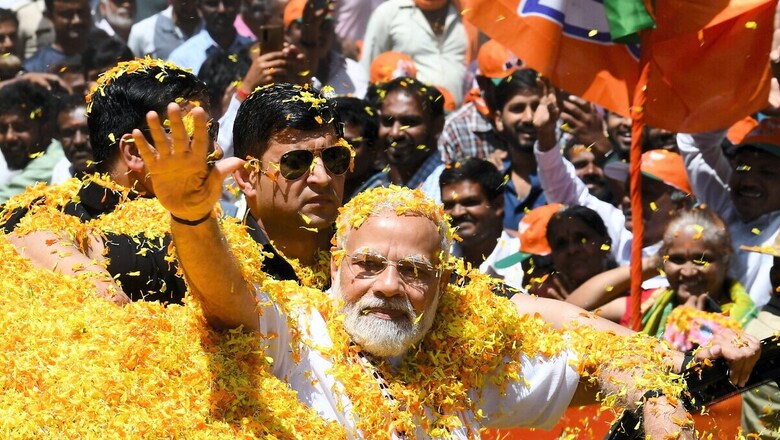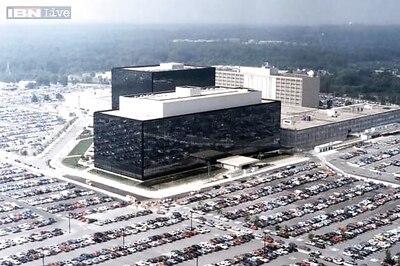
views
Karnataka Assembly elections are due in May 2023 and PM Narendra Modi has already visited the state six times this year, making his March 25 visit to the state the seventh.
He addressed two public meetings on March 12 in Mandya, in the Vokkaliga heartland of the old Mysuru region, and Dharwad in North Karnataka. Mandya is considered to be a JD-S stronghold, but the Modi magic will certainly cut into JD-S) and Congress vote bank.
While dedicating and laying the foundation stone of key development projects in Mandya, including the dedication of the Bengaluru-Mysuru Expressway to the nation and laying the foundation stone for the Mysuru-Kushalnagar 4-lane highway, the PM said that infrastructure projects worth thousands of crores are part of efforts by the double-engine government for the people of Karnataka.
He added that the Bengaluru-Mysuru expressway will reduce the travel time by one-and-a-half hours. This expressway, connecting the two major business centres, will pass through the heritage cities of Ramnagar and Mandya.
It is an extraordinary example of ‘substantive democracy’ exercised by the top BJP leadership, as BS Yediyurappa, BJP parliamentary board member and former CM, said a survey will be conducted for the names of BJP candidates, and they will be finalised and declared after being cleared by the party’s central committee.
Karnataka’s Geo-Administrative and Cultural regions
Karnataka has 30 districts and four administrative divisions (Bengaluru, Mysuru, Belagavi, and Kalaburagi), but most strikingly it has six sub-regions, which are distinctive in relation to their socio-religious, political fabric and concerns.
Coastal Region (Karaavali) — 19 Seats: It consists of Uttara Kannada, Udupi and Dakshina Kannada, and is a BJP stronghold. It is communally ultra-sensitive. In an ideological violence perpetuated by the Popular Front of India (PFI), many BJP-RSS workers were allegedly murdered. It is alleged that the PFI “organised conspiracy to radicalise Muslim youth towards violent acts of extremist nature” and “undertake targeted attacks on persons having a certain religious and socio-political lineage”
Old Mysuru – 61 Seats: It consists of Mysuru, Kodagu, Mandya, Hassan, Chamarajanagara, Tumakuru, Chikkaballapura, Kolar and Bengaluru Rural. This area is caste-wise highly polarised between the AHINDA (Dalit, BC and Minorities) and the Vokkaligas (most subsects of the Vokkaliga community are designated as Forward castes by the Government of India).
Traditionally, it has been a JD(S) stronghold, but this election season, PM Modi, in his rally in Mandya, received unprecedented response.
Bengaluru Urban – 28 Seats: Its electorate has shown abysmal voting turnout and the political clientele is formed by developmental issues along with civic concerns like water logging, water supply, traffic etc.
The STRR (Satellite Town Ring Road) Bengaluru Ring Road project, which will play a significant role by removing ‘choke points’ to decongest the city, is being developed at a cost of Rs 15,000 crore under Bharatmala Pariyojana.
One of the best things to happen to the Bengaluru Urban population will be the new 148km suburban rail project with four corridors, approved by the Centre in October 2020 at a cost of Rs 15,767 crore. Bengaluru never had a rail-based mass transit system and most commuters depended on buses and private cars, causing heavy traffic congestions.
The latest Union Budget has made an allocation of Rs 7,561 crore for expansion of the railway network in Karnataka along with the Bengaluru sub-urban railway. Apart from creating ease of movement, this will create economic opportunities and inclusive growth. Once it is operationalised, the network is expected to serve around 10 lakh commuters daily.
Mumbai-Karnataka – 50 seats: Belagavi, Bagalkote, Hubballi-Dharwad, Vijayapura, Gadag and Haveri. The Mumbai-Karnataka region is significant because it is dominated by the Lingayat community. It is a BJP stronghold. The JD(S) has marginal presence here. The sensitive Mahadayi river water-sharing issue, too, dominates this region.
Recently, Karnataka received clearance from the Centre for two Detailed Project Reports (DPRs) on Kalasa-Banduri Nala on the Mahadayi. The state government has decided to go ahead with the project. It plans to divert Mahadayi/Mandovi river system waters into the Malaprabha reservoir is a huge emotive red flag in Goa for the BJP. The Centre has to balance out the emotive issue between both the states.
Kalyan Karnataka – 40 Seats: It consists of Bidar, Yadgir, Raichuru, Koppala, Kalburgi and Bellary. Prime Minister Narendra Modi kicked off his poll campaign with his visit on January 19 to Yadgir and Kalaburagi districts to participate in various programmes. Relatively, this region is underdeveloped and is facing serious issue of illegal mining.
Mining baron-turned-politician and former BJP minister Gali Janardhana Reddy’s new Kalyana Rajya Pragati Paksha (KRPP) party could accommodate disgruntled leaders of the BJP and intrude on its vote share.
Kalaburgi is the home constituency of Congress president Mallikarjuna Kharge and he was defeated by his own protégé Umesh Yadav, who later on defected to the BJP in 2019.
In the 2019 Lok Sabha elections, the BJP won a whopping 25 of the 28 Lok Sabha constituencies in Karnataka. It is resolute in keeping this influence intact not only in the upcoming Assembly elections but also in the 2024 General Elections.
This sub-region is dominated by SC, ST and Muslim voters, with a sizeable Lingayat vote share. But the recent decision of Lingayat leader HD Thammaiah to join the Congress could prove to be a matter of concern for the BJP.
The Lingayats, as a community, have been traditionally in support of the BJP and the latter must try to retain this support as the Congress is trying to assuage the community through various poll gimmicks. Predictably, the larger share of Lingayat votes should turn towards the BJP, but some undecided chunks might go to the Congress.
Central Karnataka – 26 seats: It consists of Chitradurga Chikkamagaluru, Shivamogga and Davanagere, and is a BJP bastion. Shivamogga is Yediyurappa’s fortress. Devanagere has strong presence of the Lingayats and Chitradurga is a BJP stronghold. In 2019 General Elections, BJP candidate A Narayanawamy secured more than 50% of the total votes polled.
Double Engine Government
PM Modi’s double-engine metaphor transcends electoral politics and political rhetoric to the reinvention of India’s plurality of cultural ethos, streamlined development of hitherto neglected regions along with all-round development, inclusivity and good-governance.
India has emerged as the fastest-growing major economy in the world and is expected to be one of the top three economic powers in the world over the next 10-15 years, backed by its robust democratic credentials and mixed middle income developing social market economy strategy.
Despite the three serious jolts of Covid-19, international inflammations like the Russia-Ukraine conflict and the central banks across economies responding with synchronised policy rate hikes to curb inflation, agencies worldwide continue to project India as the fastest-growing major economy at 6.5-7.0% growth rate in FY23.
In terms of the nominal GDP, India has achieved fifth position in 2022, five notches higher than the 10th position in 2014. The Indian economy is estimated to touch $3.5 trillion mark by March 2023.
For the first quarter listing of 2022, India ranked 7th in FDI inflows as per UNCTAD reports. India is adding $1 trillion every three years to its economy. Going by these trends, India is expected to become a $5-trillion-dollar economy by 2028.
As per the 2022-23 Economic Survey of Karnataka, Karnataka GSDP is at 8.2% growth rate. And the state has the highest per-capita income of Rs 3.01 lakh, higher than the all-India parameter. It ranks third in Sustainable Development Goals with an overall score of 72 out of 100. Human Development Index of the state showed improvement from 0.432 in 1999 to 0.644 in 2021.
It is the leading state in technology and innovation. Bengaluru is rightfully called the ‘start-up capital of India’ as 40 out of 100 unicorns are located here.
Karnataka has emerged as an attractive investment hub as a result of Industrial Policy 2020-25. Single-window clearance has elevated the state’s ‘Ease of Doing Business’ ranking. The state ranks first in software exports and stands fourth in merchandise exports.
Increased capex positively impacts the national income through the multiplier effect (in India, the value of the multiplier is around 2.45), which refers to the change in the final income generated by a change in initial spending. It means if capex is around Rs 1,000, then national income will grow by Rs 2,400.
In the latest Union Budget, the Centre increased revenue expenditure by only 1.5%, while capital expenditure rose by 38%. More than Rs 10 trillion have been allocated for infrastructure development.
In the last nine years of the Modi government, the length of National Highways has increased by more than 100%. Further the Prime Minister has laid the foundation of numerous infrastructure projects worth over Rs 27,000 crore in Karnataka.
It has been rightly said by the PM that development has been taken to rural Karnataka and is not only contained to the shining enclaves of the cities, leading to a trajectory of inclusive growth. Apart from state-level schemes, centrally sponsored schemes have done wonders in Karnataka. The statistical data will second it.
Ayushman Bharat: Over 30 lakh poor citizens got the benefit of this scheme in Karnataka, saving Rs 4,000 crore in their treatment costs
PM-Kisan Samman Nidhi: Around 11 crore farmers in the country have received direct transfers amounting to over Rs 2 lakh crore till now. Of this, around 60 lakh farmers in Karnataka got around Rs 12,000 crore where more than 2.75 lakh farmers belonging to the Mandya region have been provided Rs 600 crore by the central government.
While the central pool sends Rs 6,000 for each beneficiary under the PM Kisan Samman Nidhi, the Karnataka government adds another Rs 4,000 to it.
Jal Jeevan Mission: Under the Jal Jeevan Mission, water connections were provided to over 6 crore households across India. Of this, around 40 lakh rural households in Karnataka have got piped water connection under the Jal Jeevan Mission.
Irrigation: The central government has announced Rs 5,300 crore for the upper Bhadra Lift project. Besides this, there will be a permanent solution to problems related to irrigation in large parts of Karnataka for the Kharif season. The plan is to irrigate up to 2,25,515 hectares by micro-irrigation in drought-prone districts of Chikkamagalur, Chiitradurga, Tumkur and Devanagare.
It envisages lifting up to 17.40 TMC of water in the first stage from the river Tunga to the existing Bhadra reservoir to the tunnel near Ajjampura in Tunga Bhadra sub-basin of Krishna reservoir.
The Karnataka cabinet in December 2022 approved 13 irrigation projects like Melligeri-Halgali Lift Irrigation scheme and Ammajeshwari Lift Irrigation scheme, costing Rs 5,701.38 crore in the Bombay Karnataka region (North Karnataka) comprising of Belagavi, Dharwad, Vijayapura, Bagalkot, Gagad, Uttara Kannada, and Haveri districts.
Kisan Credit Cards: Kisan credit cards are being given to fishermen in the state. The government is also working on providing better boats and technology to fishermen to increase their incomes.
One District, One Product: Its objective is realising the true potential of a district, fuelling economic growth, generating employment and rural entrepreneurship and attaining the goal of Aatmanirbhar Bharat. Through this programme, fishermen and artisans from the region will be able to get better market opportunities for their produces.
PM Modi’s metaphor has set new benchmark of co-operative federalism at its best. The achievements at both ends are evident.
The author is a senior faculty in the department of History, ARSD College, DU. She has done her MPhil, PhD program from Center for Historical Studies, JNU. Views expressed are personal.
Read all the Latest Opinions here




















Comments
0 comment